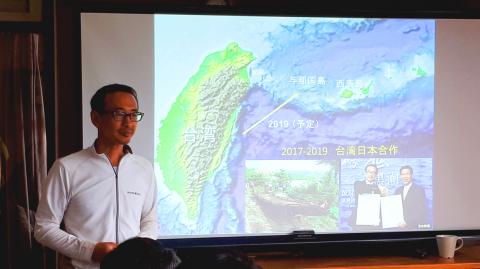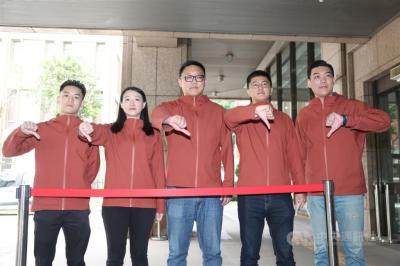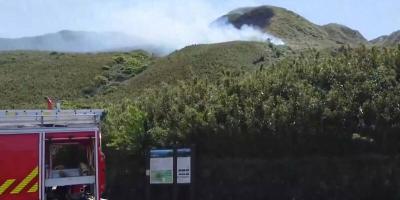The verification by Yousuke Kaifu that Yonaguni Island is visible from Taiwan underscores the Japanese anthropologist’s theory that his ancestors could have migrated to Japan from Taiwan.
Kaifu is a proponent of the theory that people migrated to Japan from Taiwan via the Kuroshio Current.
To test his theory, the National Museum of Prehistory and the Japanese National Museum of Nature and Science have collaborated on a project titled: “Navigating 30,000 Years Ago: Crossing the Kuroshio Current.”

Photo: Huang Ming-tang, Taipei Times
If Yonaguni Island was visible from Taiwan, it could have been an impetus for those living there to travel to the island, National Museum of Prehistory assistant researcher Agilasay Pakawyan said.
Humans are known to attempt risky endeavors and it is possible that even without a direct line of sight some people would have nonetheless put to sea for the sake of exploration, he said.
Taiwan is 1,253 times the size of Yonaguni and even when the weather is good, residents of the island can only see the Central Mountain Range about 10 days a year, making it much more difficult to see Yonaguni Island from Taiwan.
However, based on rumors that Yonagani Island is visible from either the Central Mountain Range or Sandiaojiao (三貂角) in New Taipei City, Kaifu visited Taiwan in 2017 and confirmed, after three days, that Yonaguni Island is visible to the naked eye when viewing at an altitude of 1,000m on Taroko Mountain (太魯閣大山), Agilasay said.
The results of Kaifu’s observations were published in Japan in March last year.
Meanwhile, a canoe launched as part of the project on Monday from Changbin Township (長濱), Taitung County, crewed by five and relying on the stars to stay true to ancient navigation techniques, arrived at Yonaguni Island on Tuesday.
The distance between Cape Wushibi (烏石鼻) near Changbin and the coast of Yonaguni Island, one of the Yaeyama Islands, is 205km when traveled in a straight line, but the closest point from Taiwan to Yonaguni is Yilan, which is only 110km away.
The success of the voyage lends credibility to Kaifu’s theory, Agilasay said, adding that the next question after confirming the validity of the migratory path is why it was used.

Taiwan is stepping up plans to create self-sufficient supply chains for combat drones and increase foreign orders from the US to counter China’s numerical superiority, a defense official said on Saturday. Commenting on condition of anonymity, the official said the nation’s armed forces are in agreement with US Admiral Samuel Paparo’s assessment that Taiwan’s military must be prepared to turn the nation’s waters into a “hellscape” for the Chinese People’s Liberation Army (PLA). Paparo, the commander of the US Indo-Pacific Command, reiterated the concept during a Congressional hearing in Washington on Wednesday. He first coined the term in a security conference last

Prosecutors today declined to say who was questioned regarding alleged forgery on petitions to recall Democratic Progressive Party (DPP) legislators, after Chinese-language media earlier reported that members of the Chinese Nationalist Party (KMT) Youth League were brought in for questioning. The Ministry of Justice Investigation Bureau confirmed that two people had been questioned, but did not disclose any further information about the ongoing investigation. KMT Youth League members Lee Hsiao-liang (李孝亮) and Liu Szu-yin (劉思吟) — who are leading the effort to recall DPP caucus chief executive Rosalia Wu (吳思瑤) and Legislator Wu Pei-yi (吳沛憶) — both posted on Facebook saying: “I

Sung Chien-liang (宋建樑), who led efforts to recall Democratic Progressive Party (DPP) Legislator Lee Kun-cheng (李坤城), was released on bail of NT$80,000 today amid outcry over his decision to wear a Nazi armband to questioning the night before. Sung arrived at the New Taipei District Prosecutors’ Office for questioning in a recall petition forgery case last night wearing a red armband bearing a swastika, carrying a copy of Adolf Hitler’s Mein Kampf and giving a Nazi salute. Sung left the building at 1:15am without the armband and covering the book with his coat. Lee said today that this is a serious

Firefighters are working to put out a fire on Taipei’s Yangmingshan (陽明山) reported earlier this morning. The cause of the fire is still under investigation. The Taipei Fire Department said it received a report of a fire at Xiaoyoukeng (小油坑) at 11:17am, dispatching four command vehicles, 16 firetrucks, one ambulance and 72 personnel. The fire is still burning on about 250m² of land, according to initial estimates, as eyewitnesses reported seeing smoke rising from the mountain. The Yangmingshan National Park Headquarters on Facebook said the Qixingshan (七星山) hiking trail starting from Xiaoyoukeng and the Xiaoyoukeng parking lot are closed as firefighters work to put